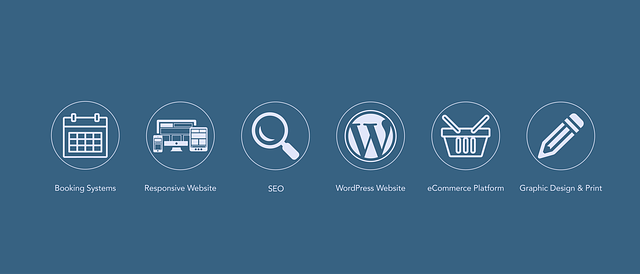Internal linking in WordPress boosts user experience and SEO by strategically connecting related content. Key steps include analyzing site architecture, identifying important pages, using relevant link text, balancing keyword usage, and automating suggestions with tools like Yoast SEO or All in One SEO Pack. Measuring CTR and engagement metrics helps refine the strategy. These practices enhance navigation, signal search engines, and drive user exploration, ultimately improving rankings and site performance.
Internal linking is a powerful SEO strategy for WordPress sites, enhancing user experience and boosting search rankings. This comprehensive guide offers practical internal link suggestions for WordPress users. We’ll walk you through understanding the fundamentals, identifying key pages, crafting relevant link text, implementing best practices, measuring success, and exploring advanced techniques using tools and plugins. Optimize your site’s structure today with these effective internal linking strategies.
- Understanding Internal Linking: Why It Matters for WordPress Sites
- Identifying Key Pages for Internal Link Strategy
- Crafting Relevant and Contextual Link Text
- Implementing Internal Links: Best Practices for WordPress Users
- Measuring Success: Tracking Click-Through Rates and User Engagement
- Advanced Techniques: Enhancing Internal Linking with Tools and Plugins
Understanding Internal Linking: Why It Matters for WordPress Sites

Internal linking is a powerful SEO strategy for WordPress sites, enabling better user experience and search engine understanding. By strategically placing links within your content to related pages on your site, you create a network that helps visitors navigate through your website effortlessly. This technique also signals to search engines that your content is valuable and interconnected, leading to improved rankings.
When implementing internal link suggestions for WordPress, consider a tutorial or strategy that aligns with your content architecture. Start by identifying key topics and relevant pages within your site using tools like Google Analytics or SEO plugins. Then, follow tips such as placing links in naturally occurring text rather than anchor text, ensuring a balance between link density and varied anchor texts to avoid appearing spammy. Regularly reviewing and updating these internal connections is also beneficial, as it keeps your website’s information architecture fresh and relevant.
Identifying Key Pages for Internal Link Strategy

Identifying key pages for your internal linking strategy is a crucial step in enhancing user experience and boosting SEO. When it comes to WordPress sites, which host a vast array of content, starting with a comprehensive analysis of your existing structure is essential. Begin by pinpointing the most important pages that serve as hubs for your website’s information architecture. These could be category or tag pages, popular posts, or core landing pages that attract significant traffic and carry high authority within your niche.
Using internal link suggestions tools available in WordPress plugins can guide this process. An internal link suggestions tutorial will provide step-by-step instructions on identifying these key pages based on content relevance and user behavior. By following tips from an internal link suggestions SEO guide, you can strategically place links to these pivotal pages throughout your site, improving both user navigation and search engine visibility.
Crafting Relevant and Contextual Link Text

When crafting internal links for WordPress sites, focusing on relevant and contextual link text is paramount for an effective internal link suggestions optimization. Link text should accurately reflect the content to which it directs, providing users with a clear understanding of what they’ll find next. For instance, instead of generic anchor text like “click here,” use specific phrases that hint at the topic or benefit. A well-crafted internal link suggestion might read, “Learn more about SEO strategies for WordPress” when linking to an article on your site that delves into SEO best practices. This approach not only aids users but also boosts internal link suggestions tips SEO by signaling search engines about the relationship between pages and enhancing crawlability.
Moreover, incorporating keywords naturally in link text can further enhance internal link suggestions SEO. However, it’s crucial to avoid keyword stuffing, which can lead to poor user experience. Use your target keywords strategically within the context of the surrounding text. For example, if you’re linking to a post about “WordPress performance optimization,” make sure that phrase appears naturally in the anchor text rather than forcing it in for the sake of SEO. This balance ensures not only effective internal link suggestions optimization but also enhances the overall user journey on your website.
Implementing Internal Links: Best Practices for WordPress Users

Implementing effective internal linking is a crucial aspect of optimizing your WordPress site for search engines and enhancing user experience. Here are some best practices to consider:
Start by identifying relevant content within your site. Look for topics that complement each other or provide further value when linked together. For instance, if you have an article about “SEO Best Practices,” consider linking to related posts like “On-Page SEO Tips” or “Keyword Research Strategies.” Ensure these internal links are contextually relevant and add value to the reader’s journey on your site. An internal link suggestions tutorial can guide WordPress users in automatically generating a list of potential links based on their content, making this process more efficient. Remember, the goal is to create a logical flow of information that encourages users to explore more pages, thereby reducing bounce rates and improving engagement metrics.
Measuring Success: Tracking Click-Through Rates and User Engagement

Measuring the success of an internal linking strategy is crucial for any WordPress site looking to enhance user engagement and improve search engine optimisation (SEO). One of the most effective metrics to track is click-through rates (CTR) from internal links. By analysing which pages are attracting the most clicks, you can gain valuable insights into user behaviour and content popularity. Tools like Google Analytics provide detailed data on where visitors are clicking within your site, allowing you to identify high-performing content and areas that may need optimisation.
Additionally, monitoring user engagement metrics such as time spent on page, bounce rate, and pages per session helps in understanding the quality of traffic generated through internal links. A well-crafted internal linking suggestions strategy should encourage users to explore more of your site, thereby increasing dwell time and reducing bounce rates. These data points are instrumental in refining your internal link suggestions tutorial and ensuring that your content is not only linked internally but also effectively guiding users and search engines alike.
Advanced Techniques: Enhancing Internal Linking with Tools and Plugins

In the quest for an effective internal linking strategy, especially for WordPress sites, advanced techniques and tools can significantly enhance your SEO efforts. One such powerful tool is Yoast SEO or All in One SEO Pack, which offer comprehensive guidance on optimizing your site’s structure. These plugins provide internal link suggestions, helping you identify relevant pages to link to within your content. By leveraging these internal link suggestions tips, you can create a seamless and hierarchical navigation system that benefits both users and search engines.
Additionally, many WordPress themes and custom development options include built-in features for internal link suggestions optimization. These tools analyze your content and propose strategic links based on keyword relevance and page authority. Integrating such plugins or developing a customized solution can streamline the process of creating an efficient internal linking structure, ultimately contributing to improved user experience and better search engine rankings.
